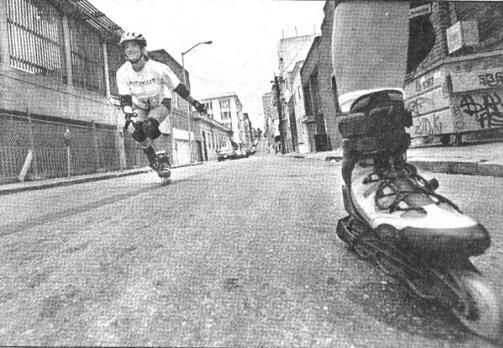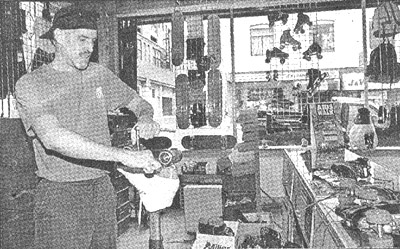| were $520 million in 1997, an 18
percent decrease from 1996. Severe discounting to dump inventory was largely to blame.
Consumers scored fantastic deals. But retailers began to sweat. San Francisco lost two
skate stores. Others had to shift ownership, location and personnel. After Cole watched
$3 million dollars in gross sales tumble by half, he sought Chapter 11 reorganization. He
shut down his large Oyster Point warehouse/sales shop and opened a smaller retail outlet
on Polk at Sutter. Here he sits in the window, assembling custom skates for discriminating
buyers.
Other Bay Area locals who make their living from skating found ways to ride out the
storm. Their success - amid the larger debacle - illustrate that skating does have
"legs." Those who make savvy choices will be able to take advantage of a sport
shifting to a steadier, more "mature" growth rate in the next two years. Skating
as a sport remains vibrant; a sharply reduced rate of growth only felt, like a
contraction of the market.
Anna Stubbs, a nationally ranked, long-distance skate racer from Alameda gave up her
effort to coax manufacturers to sponsor her career. Instead, she launched her own business
teaching womenonly skating classes for beginners. Graduates can move straight on to using
skates as a fitness tool in Stubbs-coached 90 minute workouts.
"I found terrific response," said Stubbs, 33. "There's big demand for
something like this. Women like to learn in a supportive environment. They begin very
self-conscious. But then, once they have key skills, they don't feel bothered anymore.
It's like, OK, bring on the men!"
Art Howard, owner of the Skate Pro Sports shop on Irving, credits the female segment
for helping to keep his business going. "We were written up as a good place for women
to buy hockey gear, and they really responded." Howard, 32, also said his location
attracted skaters who throng Golden Gate Park on weekends. But his ace-in-the-hole is
sales via an Internet Web site. These now form a third of his business. Half of the buyers
are from overseas. Once they know about his shop, they treat it like a tourist destination
when visiting San Francisco.
The Bay Area's sultan of skate is David Miles, 42, who helped organize the Golden Gate
Skate Patrol, started the Friday Night Skates (on the San Francisco waterfront) and formed
the event-promoting group CORA (California Outdoor Rollerskating Association). Miles said
skating's future lies in stimulating the sport at a grassroots level. More than just
gaining legal permissions for skaters to operate on city streets, this means getting civic
and industry support for skate-friendly events and facilities.
In this respect, a crucial issue for San Francisco is the fate of the Bladium - an
indoor skate hockey rink on Third Street that slurped up most of the street hockey scene
after opening in 1995. The place is wildly popular with kids: It operates above 95 percent
capacity. Co-owner Dave Walsh said he regularly exceeded his business plan by 25 percent.
But the leased site itself may get swallowed by the sprawling Mission Bay project. If
Walsh and his partners can't convince developers a skating venue would be an attractive
item, he must scour the city for a fresh and friendly site.
The backdrop for everything is an industry unkinking itself after its crash off the
growth curve. Big outfits such as Nike and Fila, which attempted to force their way in
during the crunch, failed to make much penetration in the Bay Area.
The only new player making headway is Salomon. Meanwhile, established figures such as
Rollerblade and K-2, continue to try to assess trends and assure a future' -by issuing
precisely targeted innovations.
Rollerblade, still the industry gorilla,with market share near 40 percent - has lust
introduced an off-pavement, all-terrain skate called the Coyote. K-2, whose popular
2O-model line using SoftBoot technology has spawned many imitations, will introduce an.
expandable kid's skate called the Merlin in fall and a split frame skate (with technology
based on the new Klap ice racing skates) in l999.
According to Cole, shops that can hang on past the shakeout should eventually find
themselves in excellent shape. They will be needed. All the new product in the world won't
make a difference if there are no local specialty shops around to provide parts, advice,
lessons and service.
MORE INFORMATION
CORA (California OutdoorRollerskating Association): www.cora.org.
On-a-RolI: Classes for women, (510) 864-8644, or www.timefold.com/skate
/Iessons.html.
Skate Pro: www.skatepro.com
Skates-on-Haight: www.skates.com |

